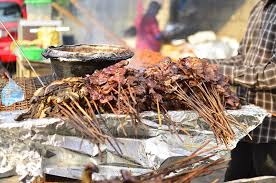
Spicy poison: How contaminated suya exposes consumers to health risks
VICTOR AYENI writes about the unhygienic practices of suya sellers, the danger inherent in the consumption of processed meat and their overall health implications on the populace
The yellow flame from the hot coals flickered with the evening wind as puffs of smoke mixed with the aroma of spices diffused from the suya spot to the passersby on the busy street corner.
Jubril, who hails from Borno State, introduced our correspondent to his friend simply named Bashiru, who grills suya in the Ojodu, Berger area of Lagos State, as they conversed in Hausa language.
“I told him that you are my good customer and he should sell you quality suya,” said Jubril, as he took his seat on a bench close to the grill.
“I didn’t want you to patronise that other mai suya (suya selller) over there,” Jubril whispered to this reporter, pointing at another trader, who also grilled suya not too far away.
“People complain that his meat pieces are expensive and not that fresh,” he added.
With a gas lantern hung in the background which illuminated the space and added a sort of ambience to the stand, Bashiru cut a part of the meat, garnished it with a delicate mix of pepper spice and gave it to our reporter for the customary “tasting.”
This seemingly simple gesture of tasting establishes a relationship between the suya maker and a potential customer and also helps to gauge how good the suya is and how much of it should be purchased.
Our correspondent also gathered that if a mai suya does not give his customer a piece of meat for tasting, he either dislikes the person or his suya is distasteful.
Spiced delicacy
Suya is probably the most popular delicacy of grilled meat sold on street corners across Nigeria.
It is a skewered meat made from ram or chicken, roasted and served with a mix of spices known as yaji which gives it a unique aroma and taste.
The thinly sliced meat is also marinated in a traditional Hausa dehydrated peanut cookie called ‘kwulikwuli,’ salt, vegetable oil and other spices and flavour, and then barbecued.
A food scientist, Chibuike Benjamin, described suya as a meal with nutritional properties important to the human body.
“Studies have shown that the beef or lamb from which suya is made contains nutritional properties such as vitamin B12, zinc, selenium, iron, manganese, magnesium, and phosphorus. Suya is also high in sodium and calories.
“The zinc nutrient helps the body to restore damaged tissue and promotes a healthy immune system. Suya also contains iron, and vitamins B12 and B6, which all play an important role in keeping your immune system in good health,” he noted.
Suya is believed to have originated with the Hausa people in northern Nigeria, but it is now popular all over the country and most of all in Lagos.
The gastronomic delicacy, which cuts across every social stratum, is often sold at joints, pubs, and pleasure spots, particularly at night.
Speaking through a translator, Bashiru explained to Sunday PUNCH how the meat used for suya is processed.
He said, “First of all in the morning, we purchase the beef from the market. It is obtained from cows and the meat is washed once or twice. We then cut it into long slices and spread it out. You have to ensure that the meat is laid out flat.
“The meat is then cooked on the grill when it is red hot and oil is regularly used to brush the grill rack and the meat is regularly turned as it gets done. This makes the meat soft and tender.
“So, before customers start thronging the spot, you will finely cut the meat, thread them onto sticks, grill them and set them aside to await customers and reheat them in the flame as you select.”
Deadly contamination
An undergraduate of Yaba College of Technology, Olasunkanmi Oyelowo, however, recalled having a stomach upset after consuming suya.
“I bought some suya that night with a friend because the aroma was irresistible. It was a N500 worth of suya. I wanted to give myself a treat and I didn’t notice anything unusual while buying or eating the meat.
“But I was awoken later that night by an excruciating stomach pain, which made me bent over as I sat on the toilet bowl. I couldn’t sleep well for the rest of the night.
“I had to get some medicines the next day. I suspected it had something to do with that suya because I’ve never had a stomach upset that bad,” he said.
Expressing anxiety about the quality of meat used for suya, a retired school principal in Ibadan, Oyo State, Mrs Kehinde Omotola, said there was a suya maker in the area reported to be using contaminated meat.
“You know, because of the heavy spice, you might not easily detect this, but people were having various complaints after patronising him and I had to stop buying his suya as well. There is no way to ascertain what kind of meat he sells,” she added.
Our correspondent visited four suya spots in the Obafemi Owode Local Government of Ogun State, where he observed as suya meat pieces were wrapped in newspapers with a sprinkling of marinade mix, fresh tomato wedges, red onions and thinly sliced cabbage.
A 2016 study conducted by researchers in the Department of Food Engineering at the University of Ilorin, published in the Ukrainian Journal of Food Science, identified the packaging of suya meat with newspapers as a major unhygienic source of contamination.
“The processors have been accustomed to collecting old newspapers from different homes and using the same to package suya meat for their customers, which are considered to be dirty and dusty, also in some homes where chemicals were being used to control insects like cockroaches and mosquitoes.
“There is a tendency of the chemicals being sprayed on the newspapers, which the chemicals, when in contact with the meat and the meat and being consumed, can pose serious health issues.
“Besides, the printed ink on the papers contains pigments, colourants, binders, additives, and photoinitiators, which can be harmful to the health of the consumers,” the study explained.
Unhygienic conditions
When our correspondent visited Bashiru on another occasion, he observed that although the table on which his grill rack was placed was elevated, some of the dust swirling from the human and vehicular movement around him were settling on the skewered meat on the rack.
Sunday PUNCH also observed that the suya being sold were handled with bare hands by the mai suyas without any recourse to hand washing or sanitisation before and after.
On several occasions, our reporter watched as mai suyas collected dirty naira notes or randomly scratched their body parts with the same hand used to hold the suya, onion, and tomatoes, while cutting them for customers.
Commenting on these unhygienic practices by suya grillers, a Lagos-based nutritionist, Mr. Emmanuel Udoh, said the condition of the processed meat as of the time it was purchased contributed to the contamination.
He explained that the quality of water used to wash the meat to be used for suya as well as the hygienic level of the environment and other utensils used could pose health risks to many consumers.
Udoh said, “Speaking of the hygiene condition, we are not really certain of the condition of the meat being used; whether they are spoiled, almost spoiling or good-to-eat.
“Most bacterial meat spoilage is caused by lactic acid bacteria; these include many species such as lactobacillus, leuconostoc, pediococcus and streptococcus, which are physiologically related to a group of fastidious and ubiquitous gram-positive organisms.
“The other possible sources of contamination are through the slaughtering of sick animals, washing the meat with dirty water by butchers, inappropriate exposure of the suya meat, contamination by flies through processing done close to dirty places, contaminated equipment such as knife and other utensils, and addition of spices that are not healthy to the body.”
Also, a clinical pharmacist, Mr James Ucheaga, during an interview with Sunday PUNCH, revealed that suya consumption made infestations with parasitic worms easier.
He said, “Some animals before slaughter are infested with cysts of worms such as tapeworms and other worms. Cows and pigs are intermediate hosts of these organisms and humans who consume uncooked or not properly cooked meat, can consume these cysts in these animals, which hatch to become tapeworms that attach to the gastrointestinal tract (intestines) of the consumer.
“Generally, worms, especially tapeworms, are parasites. They have hooks and suckers, which they use to attach and suck nutrients from the intestine of the person, thereby leaving the individual malnourished.”
Ucheaga added that other infections can result from unhygienic conditions and unsanitary practices mai suyas follow.
“The condition in which suya is prepared is most times very unhygienic. For instance, they do not wash their hands after handling dirty materials and dust frequently settles on the meat. Microbes are known to thrive in areas that are not hygienic.
“The flame that is used to prepare these meats is often the yellow part, which scientists will tell you is unlike the blue flame. It doesn’t kill these parasitic cysts; it only grills the external part of the meat.
“Furthermore, people who consume suya, especia





